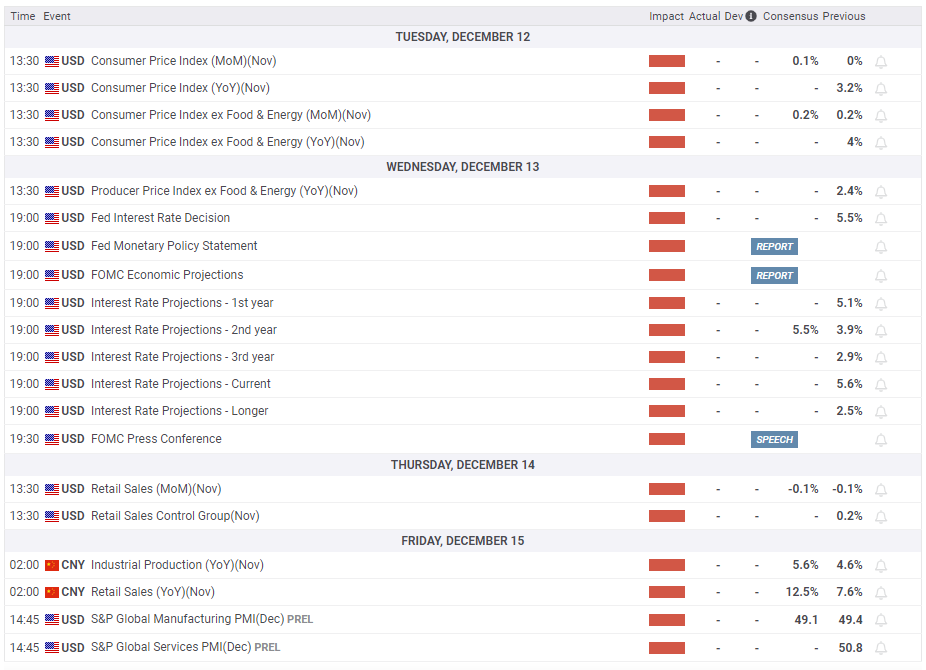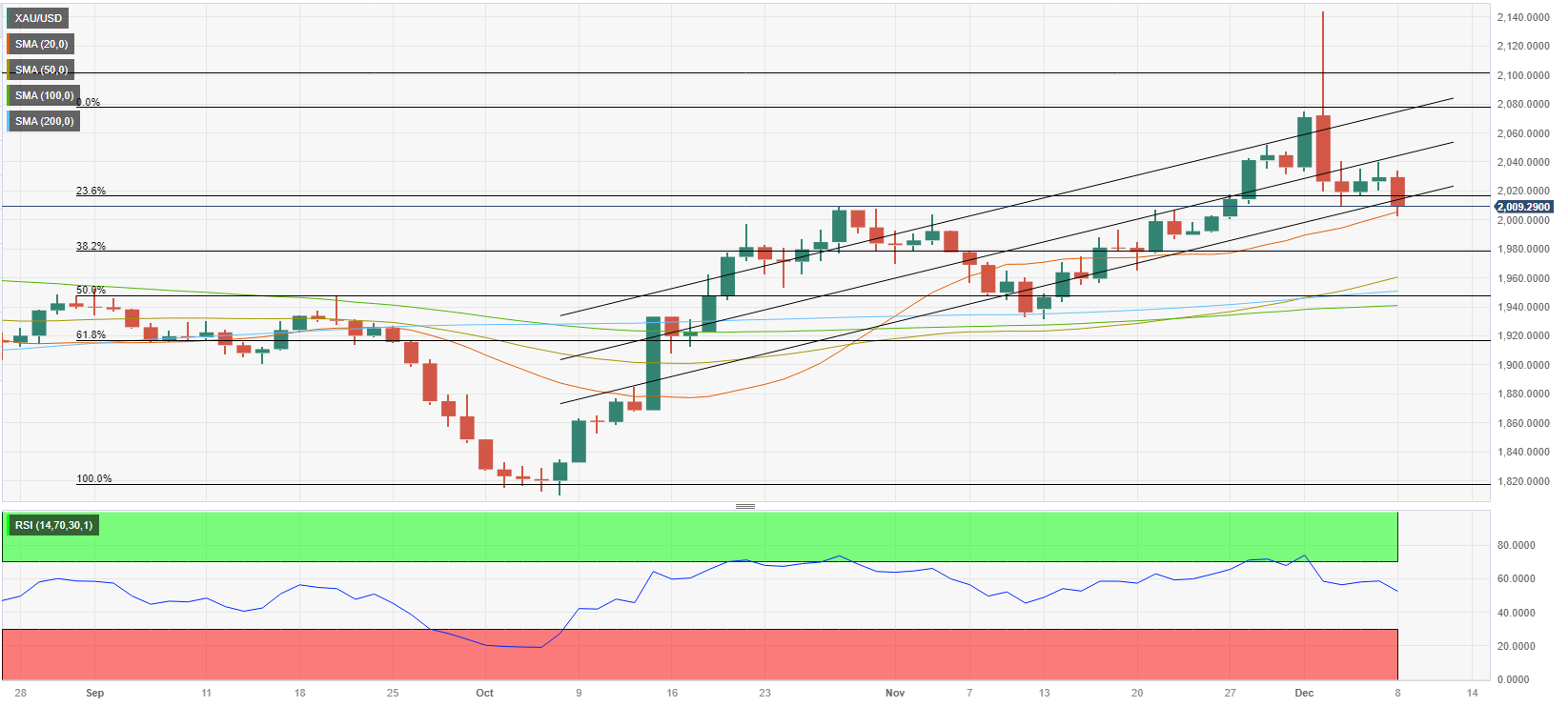- Gold reversed its direction after setting a record-top this week.
- The near-term technical outlook points to a loss of bullish momentum.
- Inflation data from the US and the Fed’s policy announcements could drive XAU/USD’s action.
Following an impressive rally at the beginning of the week, Gold turned south and snapped a three-week winning streak. As market focus shifts to next week’s key data releases and central bank events, XAU/USD’s technical outlook points to a loss of bullish momentum.
Gold price retreated sharply after setting a record-high
Gold opened with a huge bullish gap and reached a new all-time-high near $2,150 in the early Asian session on Monday as markets reacted to escalating geopolitical tensions. After Yemen’s Houthi rebels hit three commercial ships in the Red Sea on Sunday, a US warship responded by shooting down three drones. Yemen’s Houthi movement acknowledged that they had targeted two Israeli ships, stating that they were responding to calls from Islamic nations to stand with the Palestinian people. This development revived fears over the Israel-Hamas conflict turning into a widespread crisis in the Middle East. Following the record-setting upsurge, profit-taking triggered a deep correction in XAU/USD and the pair closed in negative territory near $2,030.
On Tuesday, the data from China showed that Caixin Services PMI improved to 51.5 in November from 50.4. Later in the day, the US Bureau of Labor Statistics (BLS) reported that the number of job openings on the last business day of October declined to 8.7 million from 9.3 million in September. On a positive note, the ISM Services PMI edged higher to 52.7 in November from 51.8 in October, pointing to an acceleration in the business activity’s growth in the service sector. The benchmark 10-year US Treasury bond yield fell more than 2% after mixed US data and helped XAU/USD find a foothold.
Employment in the US private sector increased by 103,000 in November, the Automatic Data Processing (ADP) announced on Wednesday. This print fell short of the market consensus of 130,000. Although the risk-averse market atmosphere allowed the US Dollar (USD) to stay resilient against its rivals despite the uninspiring employment data, Gold’s downside remained limited as US yields continued to stretch lower.
China’s trade surplus widened to $68.39 billion in November from $56.53 billion, the General Administration of Customs of the People’s Republic of China reported early Thursday. On a yearly basis, imports declined by 0.6% in the same period. Gold managed to hold its ground and closed near $2,030 but the action in financial markets remained choppy ahead of Friday’s highly-anticipated US November jobs report.
The BLS’ monthly publication revealed that Nonfarm Payrolls increased by 199,000 in November. This reading followed October’s increase of 150,000 and came in better than the market expectation of 180,000. Moreover, the Unemployment Rate edged lower to 3.7% from 3.9% in October. The benchmark 10-year US Treasury bond yield turned north and advanced beyond 4.2% following the labor market data and forced XAU/USD to retreat below $2,010.
Gold price could react significantly to US data and the Fed’s dot plot
Markets have plenty of data releases and macroeconomic events to keep an eye on next week before holiday trading takes over.
The Consumer Price Index (CPI) data for November will be released on Tuesday. In October, the monthly CPI was unchanged. A negative print in this data could weigh on the USD with the initial reaction and provide a boost to XAU/USD. Investors will also pay close attention to the Core CPI reading, which is expected to increase 0.2% for the second consecutive month. A reading of 0.4% or higher could help the USD find demand.
On Wednesday, the US Federal Reserve (Fed) will announce its interest rate decision and release the revised Summary of Projections (SEP), the so-called dot plot. September’s SEP showed that policymakers’ projections implied one more 25-basis-point rate hike this year and 50 bps of rate cuts in 2024. At this point, it would be a significant bullish surprise if the Fed opted not to leave the policy rate unchanged at 5.25%-5.5%. Market participants will scrutinize the dot plot to try to figure out the timing of the policy shift.
According to the CME Group FedWatch Tool, markets are currently pricing in a nearly 60% probability that the Fed will lower the policy by 25 bps as early as March. In case the revised SEP points to a total of 100 bps or more rate cuts next year, US yields could push lower and XAU/USD could gather bullish momentum. On the other hand, a no-change in 2024 rate expectations could have the opposite impact and trigger a USD rally. Fed Chairman Jerome Powell’s last press conference of the year could also impact XAU/USD’s action following the immediate reaction to the SEP. Powell is likely to push back against the market expectation of an early policy shift in 2024. Such a tone shouldn’t be surprising, however, given the Fed’s data-dependent approach.
On Thursday, the European Central Bank (ECB) and the Bank of England will also announce monetary policy decisions. In case the ECB and the BoE adopt a more cautious tone than the Fed regarding a policy shift in 2024, investors could price in a policy divergence. In this scenario, EUR/USD and GBP/USD could push higher and the broad selling pressure surrounding the USD could support XAU/USD. Conversely, dovish surprises from the ECB and the BoE could lift the USD and weigh on the pair.
S&P Global will release the preliminary Manufacturing PMI survey on Friday. Investors are likely to ignore this report while assessing the central bank outcomes.


Gold technical outlook
At the time of press, Gold was trading slightly below the ascending regression channel coming from early October. In the meantime, the Relative Strength Index (RSI) indicator on the daily chart declined toward 50 after rising to overbought territory above 70 on Monday. Both of these technical developments point to a loss of bullish momentum.
On the downside, $2,000 (psychological level) aligns as immediate support. A daily close below this level could attract technical sellers and open the door for an extended downward correction toward $1,980 (Fibonacci 38.2% retracement of the October–December downtrend) and $1,960 (50-day Simple Moving Average).
Gold needs to stabilize within the ascending channel by turning $2,020 into support to turn bullish again. In this scenario, XAU/USD could face resistance at $2,060 (mid-point of the ascending channel) before targeting $2,080 (upper limit of the ascending channel, static level).






